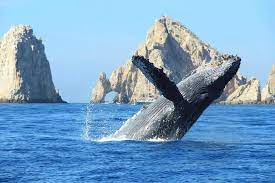Whale watching in Cabo
One of Cabo San Lucas’s major attractions is whale-watching, and it attracts thousands of enthusiasts every year. Cabo is known for its diverse marine life and is home to several species of whales that can be spotted in their natural habitat during certain times of the year.
One of the most common whales to be spotted in Cabo San Lucas is the humpback whale. These majestic creatures migrate from the colder Alaskan waters to the warm waters of Baja California between November and March each year. During this time, it’s possible to see humpback whales breaching, tail-slapping, and even hear their songs as they communicate with each other.
Another whale species that can be spotted in Cabo San Lucas is the gray whale. Gray whales migrate from the Arctic waters to the lagoons of Baja California, to give birth and nurse their young between December and April. Whales are known for their friendly and curious behavior, often approaching boats closely, making for a thrilling whale-watching experience.
Other species of whales that are occasionally spotted in Cabo San Lucas include blue whales, orcas (killer whales) and fin whales. However, these sightings are less common compared to humpback and gray whales.
Gray Whales tend to nest near shore, so there is a good chance you can see them without taking a boat tour. While there are many other species of whales in Cabo waters that you can only see why setting out into deeper waters, It is not uncommon to see a Gray whale and her babies breach from your perch on the beach.
Many whale-watching tours are available in Cabo San Lucas, operated by experienced guides who follow local regulations for responsible whale-watching. These tours usually take place on boats and provide an opportunity to witness these magnificent creatures up close while learning about their behavior, biology, and conservation efforts. Mid-day tours usually see the most significant number of whales, followed by afternoons and mornings. One thing to consider is that the mornings are usually the calmest sea conditions, making the boat ride more comfortable.
When planning a whale-watching trip in Cabo San Lucas, choosing a reputable tour operator is crucial, as following all local regulations and respecting the whales’ natural habitat. It’s also advisable to bring sunscreen, a hat, appropriate clothing for protection from the sun and wind, binoculars, and a camera to capture the unforgettable moments of seeing whales in their natural environment.
Read more about moving to Cabo in our handy Los Cabos Relocation Guide
